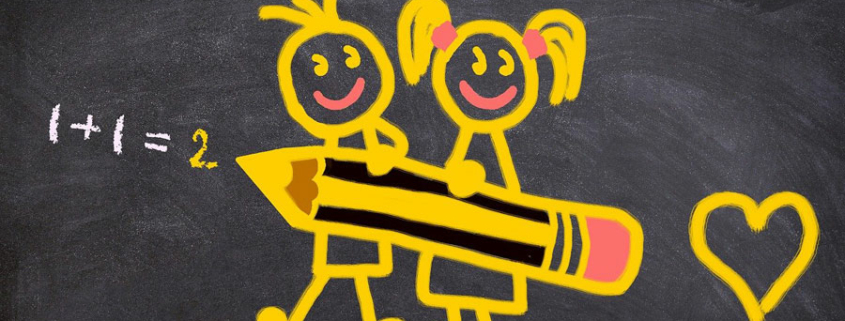Proven Tools to Raise Student Intelligence
Catching Your Students Up?
That sounds like a line out of a comedy routine or science fiction! After all, not long ago, educators (just like you) believed IQ was fixed. They said, “You either got it or you don’t.” Times have changed, so it’s time for an update. Today we say, “Either you are a lifelong learner, or unfortunately, you’re just getting older.” Interested in teaching strategies that can raise IQ? If so, this is for you.
Background
Here is this month’s insight. The intelligence of your students is malleable. In this issue let’s blow away that old “fixed IQ” myth. The evidence is overwhelming. Compelling research showed what researcher Harold Skeels documented in the early days of IQ research in orphanages. His experimental group in multiple published studies (Skeels, 1939, 1942, 1966) showed that increases in IQ were not just possible but replicable, lasting, and dramatic. Even in a 20 year follow-up, Skeels showed that his experimental group (originally labeled “unsuitable” for adoption), averaged a lasting 28 point average IQ increase.
By contrast, the control group (also labeled “suitable” for adoption) that received zero intervention, averaged a 26 point average loss in IQ in the orphanage. Multiple other education, lifestyle, work, and family results were notably better in Skeel’s intervention group. Skeel’s data showed what works: 1) a caring adult, 2) enriching activities to grow the brain, and 3) the growth mindset that “the lower the starting point, the higher the upside.”
Today, many teachers still have low expectations of their students, especially of those who are so-called “underperforming.” This includes students of color, those with disabilities, or emerging bilinguals who are consistently isolated, labeled, and left off the lists for advance placement, gifted, or college prep classes. You never want to be one that does that to kids. The biases may be stereotypical or teachers may simply lack awareness and tools to aim high for students. Let me re-state this another way. Many students miss out on the opportunities and the chance at a richer, more fulfilling life. That begins in the classroom, and it ends up hurting everybody.
You may already know that we have many ways to measure IQ. Two of them are: 1) fluid IQ (‘in the moment’) intelligence and 2) crystalized (‘gained over time from content and skills’) intelligence. Both are valuable and both can be raised.
Let’s unpack what the evidence tells us so you can be a more amazing educator. Why? It is likely this will be each student’s only chance, in their lifetime, to get gains like this.
The Research
First, did Harold Skeel’s research hold up over time, or did science overturn the mindset that one could raise IQ?
Let’s start with a massive sample. Across 142 effect sizes from 42 data sets (worldwide) involving over 600,000 participants, researchers did find consistent evidence for positive effects of education on cognitive abilities. We know today that simply attending school raises student IQ between 1 and 5 points per school year (Ritchie & Tucker-Drob, 2018). A Demark study showed a gain of 4.3 IQ points for each year in school with 7,389 students (Hegelund, et. al, 2020).
In a recent Norwegian study, the research included a period of mandatory school attendance (which added 3 years for high school), as well as inclusion for the ‘Flynn effect’ (that being that the world average IQ has gone up slowly over the last 50 years). This study found that each additional year of schooling raises IQ by a statistically significant 3.7 IQ points annually (Brinch & Galloway, 2012). Yes, IQ can change and for the better.
The older, strong hereditarian position has also been challenged for decades, especially with the role of socioeconomic status (SES) in the development of intelligence. It turns out that social inequality and social policies can have a profound effect on the heritability of educational attainment (hence, IQ) in the general population (Selita, Fatos & Yulia Kovas. (2019). In short, IQ is flexible and malleable (vs. fixed and permanent).
Now, you know; the supposedly “fixed” (or crystalized) IQ can be improved.
We have seen that one way to impact student intelligence is via school experiences. You have seen the evidence above that school (a social, physical, emotional, and academic context) appears to exhibit a broad, positive influence over time. Regardless of the known heritability for IQ (it does vary among populations), the message remains: keep kids connected with a caring adult and in school.
But there’s a second way to impact student intelligence. Also known as “fluid IQ,” it is flexible, requiring the use of ‘in the moment’ (vs. accumulated knowledge) smarts. The fluid IQ is known as Gf (generalized IQ that is fluid). It is a strong predictor of academic success, lifetime earnings, and other significant life outcomes (Deary, Strand, Smith & Fernandes, 2007).
Using Gf, multiple specific pathways show a raised IQ pathway through building executive function skills (memory, problem-solving, speed of processing, reasoning, creativity, managing inhibition, etc.). These skills show up on nearly every type of IQ test.
The best-known way (so far) to boost this kind of IQ is via executive function skills, memory, problem-solving, creativity, etc.). Let’s find out what researchers have done using a narrow, replicable path you can use in your classroom. In other words, “What is it that teachers (vs. whole schools) can do specifically to raise IQ?” There are several studies which show how to raise IQ through 1) the use of creative problem-solving and 2) working memory.
A large meta-study found that teaching divergent thinking as well as convergent thinking improved intelligence (Ma, Hsen-Hsing. 2009). Other studies have shown a link between creativity and increased gray matter (Jauk, 2015).
Another well-documented study had a relatively large sample size (nearly 300) of high-school age students. It lasted over three years, and used control group and experimental groups. The measurement included 28 measures of intelligence. It was based on random assignment of school classes both to the control and treatment groups.
The results? The experimental group showed a 10-15 point IQ increase. This is the equivalent to an effect size between 0.67 and 1.0 versus the control group (Stankov & Lee, 2020). In intelligence research where an IQ score of 15 points is equal to one full standard deviation, a 10-point boost is massive. What was the ‘secret sauce’? We’ll get to that in a moment.
First, Susan Jaeggi’s work showed that improving working memory may contribute to higher IQ (Buschkuehl & Jaeggi, 2010). Improvements in working memory capacity have been shown to explain at least half of variance in fluid intelligence across individuals (Kane, Hambrick & Conway, 2005). We now know that working memory capacity and fluid intelligence are strongly related constructs (Ackerman, Beier & Boyle, 2005).
Practical Applications
Now, let’s sort out what we have. IQ can be enhanced over the long haul and with specific skill training in school. Here is the critical understanding about memory skill-building in your students: Yes, memory skills can be improved. Invest 10-15 min./day, 3-5 days/wk. for 8-10 weeks. After that, use the skills learned in the classroom to keep them sharp. Where’s the content for this?
The ability to generalizable the acquired skills crucially depends on the diversity of contexts in which skills are acquired and practiced. In short, remember to use the class content as the material for the skill building and you’ll get solid results. Also, teach or train using either math/science symbols OR language arts symbols (e.g. alphabet, English language). Use a symbol system for 8-10 weeks, then a 2-4 week pause before engaging another symbol system. The two systems (numbers/letters) engage two very different pathways.
ACTION STEP: Where do you learn HOW to teach working memory? I’ve prepared a free tutorial you can view now. Go to: jensenlearning.com/workingmemory.
Secondly, you may recall the high school study above where IQ was raised 10-15 points above the control group. In this study, the ‘secret sauce’ was when students were given creative problem solving. The study mentioned earlier showed creativity training can also enhance IQ. At the high school, students were given nearly impossible problem-solving requiring divergent thinking.
One example of this thinking was, “The earth’s population is doubling quite fast. In what ways could we feed the world’s population using different means than we are using today?” Another example would be, “It’s possible that our moon may have valuable resources on it. How could you transport goods from the moon back to the earth without using rockets?”
A third example uses the prisoner dilemma model: “I was captured by a gang and their leader had my hands and legs tied up so that I could not move. They did not gag me up though, and I was able to use my mouth freely. The leader of the gang hung a piece of bread exactly five centimeters away from my mouth. He then laughed and said: “If you manage to eat this piece of bread, I’II set you free. He knew that I could get no help. Also, to ensure that I could not roll over or move closer to bread, they tied me to a tree. Nevertheless, I managed to free myself. How did I do it?”
Students in the experimental groups were asked to list as many ways as they could think of to solve each of the weekly problems. The acceptable solutions for the example above included blowing at the bread until it swung back towards the speaker’s mouth. It was collaborative, divergent problem-solving at its best. Researchers concluded that prolonged intensive training in creative problem-solving had led to substantial and positive effects on intelligence during late adolescence (ages 16–19). The data was conclusive, one hour a week, for two years, built a better brain.
ACTION STEP: Start by locating examples of problem-solving content that you can vary for your grade level. Then share them with other grade-level or subject level staff. You may also be able to find these in the gifted curriculum.
Now for my biggest fear. You have just heard me say, “Teach working memory or creative problem-solving.” The big question is, “Are you up for the challenge?” Or, do you still use the ‘time bias’? Many teachers would respond with, “I’m just too busy; I’ve got no time for changes to help my students soar like eagles.”
If you feel that way, I am sorry… I have failed you. I failed to activate your choice of playing the ‘long game.’ Biases are shortcuts to save time and are often about the ‘short game.’
You see, life goes by so fast that many would say, “Live in the moment, smell the roses, life is short.” And they’re right. Life is about savoring the smell of fragrant flowers, eating a great meal and enjoying hugs from friends and family.
But most everything in life that’s worth having over a lifetime requires the ‘long game’, too. At school, it includes building relationships and fostering cognitive capacity. At home, the list includes developing relationships, appreciating the daily blessings and saving for retirement. Choose right now; what have you decided on doing? Then begin today.








 We could focus on all the “holiday” stuff (like how to help you “navigate the holidays without adding inches to your figure”), but it’s the school year and we turn to how to affect one of the “Big Four.”
We could focus on all the “holiday” stuff (like how to help you “navigate the holidays without adding inches to your figure”), but it’s the school year and we turn to how to affect one of the “Big Four.”


